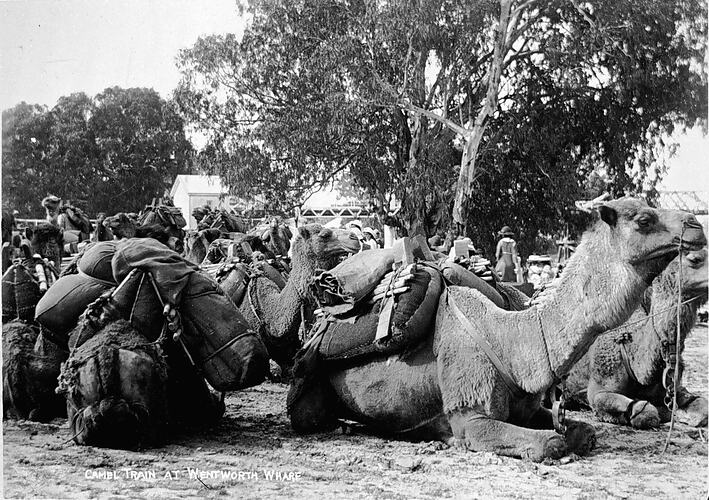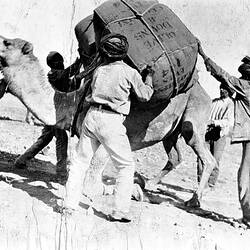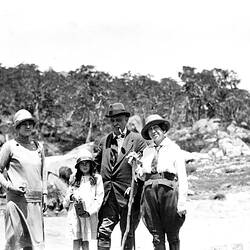Summary
A camel train resting in Wentworth, New South Wales. The image was created by R. W. Martin in circa 1905. An inscription at the bottom reads 'Camel train at Wentworth wharf.'
The camels and their cameleers helped carry supplies inland for the mining and sheep industries, aided the building of the Overland Telegraph Line, the Canning Stock Route, major fence lines and the Trans-Australia and Central Australian railways. They carried pipe sections for the Goldfields Water Supply, supplied goods to inland towns, mining camps, sheep and cattle stations and also Aboriginal communities. Wagons hauled by Camels moved wool from sheep stations to railheads, pulled scoops in the construction of dams, and helped with ploughing and other farm work.
Description of Content
A camel train resting. The camels are all laden down with packs, and the area in which they rest is shaded by trees. An inscription at the bottom reads 'Camel train at Wentworth Wharf.'.
Physical Description
Black and white negative.
Significance
The first camel was imported to Australia in 1840 from the Canary Islands. This first camel was soon followed by 24 others, imported from India and Palestine to help in the ill-fated Burke and Wills expedition. With them came their cameleers. The camels present in Australia are almost exclusively Dromedaries (Arabian Camels), and it wasn't long before Australia began breeding their own camels, and exporting them all over the world. The first camel stud was set up in 1866, by Sir Thomas Elder at Beltana Station, South Australia. Australian working camels were of a better quality than those imported from elsewhere. They were in increasing demand for exploration and long distance travel through desert regions as they proved to be perfectly suited for the Australian environment. Camels were however still being imported up until 1907. Over 10,000 camels were imported, and with them came the Afghan Cameleers (known as 'Ghan's for short). They received a mixed reception in Australia. Camel teams would usually consist of about 70 camels, and 4 cameleers and could travel between 32-40 kilometers in a day and each individual camel could carry up to 600kg on their back. The camels and their cameleers helped carry supplies inland for the mining and sheep industries, aided the building of the Overland Telegraph Line, the Canning Stock Route, major fence lines and the Trans-Australia and Central Australian railways. They carried pipe sections for the Goldfields Water Supply, supplied goods to inland towns, mining camps, sheep and cattle stations and also Aboriginal communities. Wagons hauled by Camels moved wool from sheep stations to railheads, pulled scoops in the construction of dams, and helped with ploughing and other farm work. The cameleers were mostly from Afghanistan and its tribal districts, but many also came from India, Pakistan, Punjab and Baluchis. The Camel drivers were the founders of Islam in Australia. They built the first mosques, nothing more than rough outback shelters, and today's modern Mosques in Adelaide and Perth were built with cameleer donations. Inter-marriages did occur, facilitating assimilation into the wider community. Until WWI the 'Ghan's and a few indigenous men were the only people who worked with the camels, but after the war men who had worked with camels in the Middle East came back to become some of the first white Cameleers, making it no longer a primarily Muslim exclusive profession. However, with the rise of the motor vehicle camels and their cameleers were soon replaced. The cameleers were forced to find alternative employment, and the camels either shot or left to roam free. As a consequence Austalia now has the only known herd of wild Dromedaries, which could number over 600,000 and is expected to increase in the next 8 years. 'The Ghan' railway, which travels from Adelaide, through Alice Springs, to Darwin is named after the Afghan Cameleers, and is a tribute to their contribution to overland travel and the building of Australia.
More Information
-
Collection Names
-
Collecting Areas
-
Acquisition Information
Copied from Bruce Pay, 27 Oct 1987
-
Place & Date Depicted
-
Creator
-
Format
Negative, 35 mm, Black & White
-
Inscriptions
Printed in white, lower left corner: "CAMEL TRAIN AT WENTWORTH WHARF"
-
Classification
-
Category
-
Discipline
-
Type of item
-
References
[Link 1] viewed 28.04.2009. [Link 2] viewed 13.05.2009. [Link 3] viewed 13.05.2009. Stevens, Christine, 'Tin Mosques and Ghantowns : A History of Afghan Cameldrivers in Australia', Paul Fitzsimons: Alice Springs (2002).
-
Keywords


